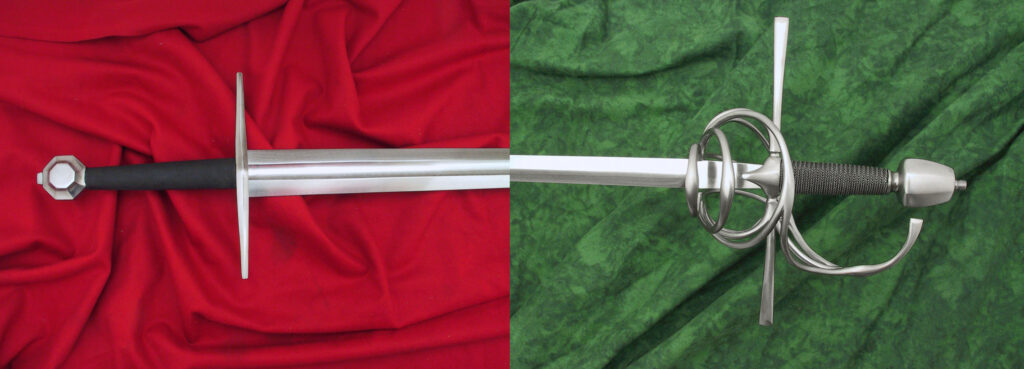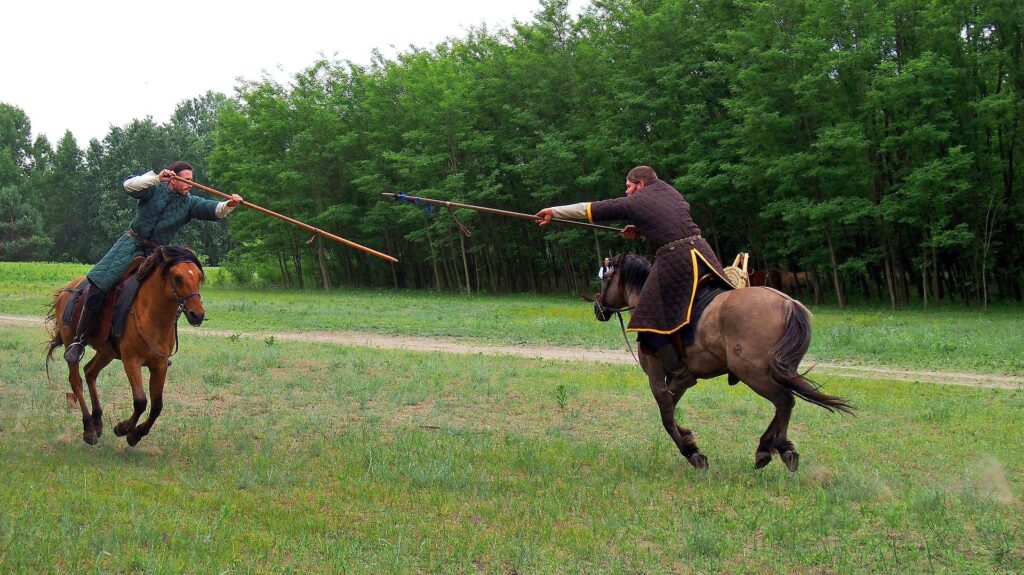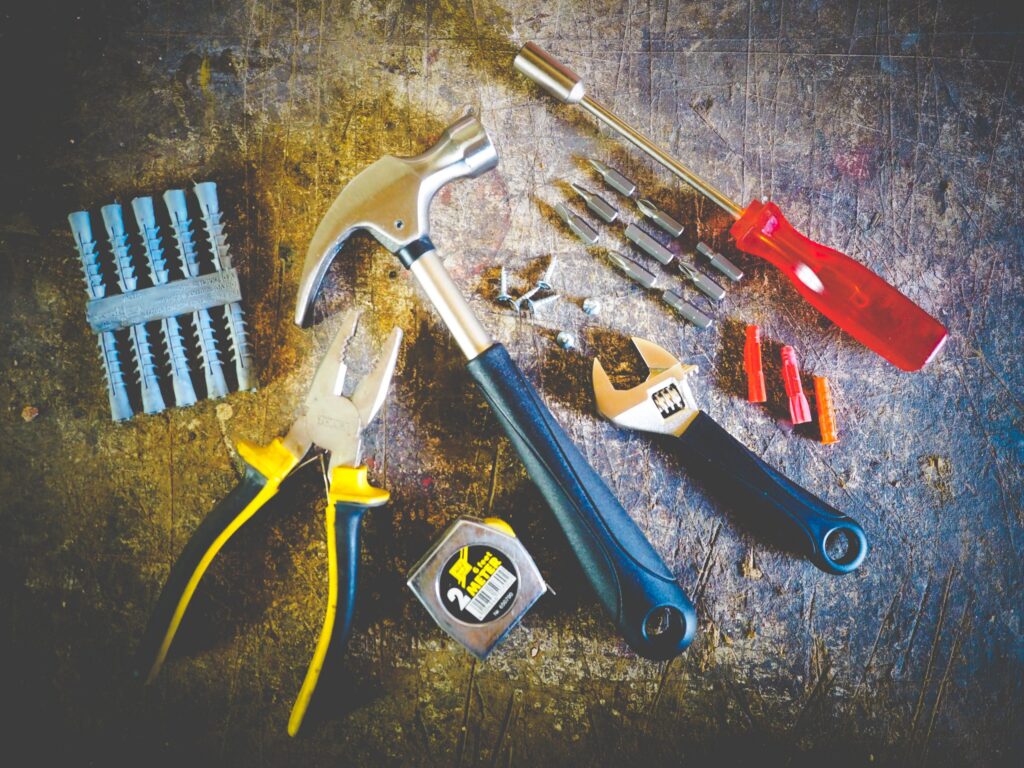Rapier vs Longsword: Comparing and Strategizing

Twice a month Academie Duello hosts a sparring night we call Open Floor. Members from all of our programs come out on this one night to train, practice, and fight. One of the more interesting and entertaining explorations is the meeting of different weapon disciplines.
In this post I want to explore one of the most challenging and interesting: Rapier vs Longsword.
Comparing the Weapons
The rapier is a long, thin-bladed weapon, tuned for one-on-one duelling. It can be extremely dextrous and fast and the postures of the weapon are oriented toward hiding targets and maximizing power in the thrust.
The longsword is a highly versatile weapon. It’s a powerful cutter and thruster. Having two hands on the handle means that the wielder can have a tremendous amount of leverage and thus more easily control the centre over someone with only one hand on their sword. Yet having two hands engaged on the weapon also means presenting more targets, both of your arms and your more-squared torso.
Rapiers and longswords often have similar blade lengths with the rapiers greater reach primarily coming from being held single handed and the postures being more profiled. Longsword blades tend to be less flexible and broader. Longsword hilts are simpler, usually just a crossbar. Rapier hilts provide greater protection around the wielder’s hand with rings, plates, or cups.
Maximizing Strengths, Minimizing Weaknesses
As in any match-up the important thing is to recognize and maximize the strengths of both yourself and your weapon while minimizing the weaknesses (ideally avoiding those disadvantageous conditions completely).
A rapier fighter should be seeking to use their greater range, smaller target, and greater protection from their sword hilt against their longswording opponent. In turn they need to avoid getting into any fights over leverage and not let their opponent get past their point.
The longsworder wants to lure the rapier fighter into binds and committed actions where the greater leverage can be used to win a crossing or clear the rapier completely from the engagement. They also want to avoid chasing the rapier point around and play a more centered sword-forward game while using distance to protect their exposed arms.
5 Rapier Strategies Against the Longsword
- Stay Free
Avoid blade engagement. Especially in the first distances. If your opponent is holding their sword withdrawn, threaten the centreline and if they try to clear your sword, disengage the clearing and maintain the on-line presence of your point.
If the opponent is presenting their sword then keep your point free by placing it underneath the opponent’s blade or hands.
- Hit the Hand
As the opponent seeks to control or clear your sword, use those moments to disengage and strike into the hand or forearm. Keep to a farther distance. Make the strike and withdraw immediately.
Once you’ve wounded your opponent’s arms they’ll be much easier to deal with.
- Gain Deep
Keep your sword free until you can strike with a high commitment that allows you to engage the hilt of your sword against your opponent’s point for maximum leverage.
Use feints or attacks to the opponent’s hands to lure them into chasing. After they’ve chased a couple times, in the tempo of their second (third?) chasing, advance your hilt deeply. Ensure that you place your true edge and hilt between your opponent’s sword and you and strike to the body or face. It is often helpful to do this with a passing lunge.
- Play at Distance Extremes
When you go in, go in all the way. After you gain deep continue passing toward your opponent. Withdraw your sword to keep the point in front of them, allow you to get past their point, keep your hilt defensive, and consider using your offhand to control or bind their arms. You’ll need to be comfortable in the grapple.
If you’re not playing close, stay out at a distance where you can threaten your opponent’s arms but they can’t easily enter or attack to your body.
- Yield to Pressure
Sometimes a good longsword fighter is going to get control of your sword or expel it. In these moments you want to be really responsive to yield to that pressure, drop your point while raising your hilt. In this way you can hide behind your blades cover while you create distance and get your point back on line. Be quick on your feet and don’t hang out in measure without the cover of your sword.
5 Longsword Strategies Against the Rapier
- Win the wideplay with distance
Ideally you want to clear the opponent’s rapier so you can safely enter past their point into a place where cuts are superior to thrusts. To do this you need to be patient, hold the edge of your opponent’s range and find a moment to successfully clear their weapon.
Don’t overcommit to your first clearing attempt. Instead make a low-commitment clearing attempt specifically to induce your opponent to disengage, then strike their sword again in its new position. Alternately try to invite your opponent to commit to a deeper attack, and while they do so withdraw and clear their sword while it’s fully extended.
The most important thing is to keep working at a distance where you can strike the opponent’s sword but they cannot easily get to your arms or body without overcommitting.
- Use the Thumb Grip to Maximize Dexterity
Sometimes the best thing to do is to try to beat the rapier fighter at their own game by bringing your sword to the centre. Here you can seek to find and gain the greater angles over their sword. A typically superior position to do this from is one where you place your thumb on to the flat of your sword (or the side of your handle aligned with your flat) with your thumb on top. From this position you can easily direct your point by directing your thumb to the left and right. You’d then be using your true edge to the inside and your false edge to the outside, both edges having become equally strong. This avoids the time delay of turning your edge and allows you to maximize the control and dexterity that having two hands on the sword can give you.
- Beat them into submission
Use short sharp strikes to your opponent’s weapon delivered from a position of proximity. No big wind-ups. Place your weapon forward and then use your bottom hand to help you make short beats. If the opponent disengages, beat to the opposite side. If you succeed in clearing them, as they chase back to the line disengage and beat them on the other side to send them even further or clear them completely. The false edge can readily be used to beat the blade away, leaving your true edge online to control or attack.
When you’ve displaced them far enough, close the measure for a deeper attack or get past their point with a strong cover.
- Take their sword from them
The extended nature of rapier postures, plus the fact that they’re only holding their sword in one hand, make the rapierist more vulnerable to disarms. Enter past the point using the strategies above then seek to enwrap their blade with your offhand or seize their hilt. (Always and only do these sorts of techniques with very advanced practitioners and under very controlled circumstances.)
- Surprise them with reach
Though using two hands on your sword will shorten your reach, nothing says that you can’t let one of your hands go to achieve a rapier style reach for yourself. Use one of the previous strategies to set the rapierist into chasing, then instead of moving in under a cover, drop your lead hand and cast a long range thrust with your pommel hand.
Be sure to step forward with whichever foot matches the hand on the pommel (i.e., if you’re a right hander, your left hand will be on the pommel, so you’ll step forward with the left foot to cast the longest and most covered one-handed thrust). This sudden increase of your range will often catch an opponent off guard. Just don’t overuse this power and ruin the surprise.
Practice Makes Perfect
Every one of these strategies is best employed with some focused drilling. All ten of them are explored in the Masters Club workshop on Longsword vs Rapier complete with drills, exercises, and examples for each one. The recording is available to all DuelloTV subscribers. You can check it out here.



